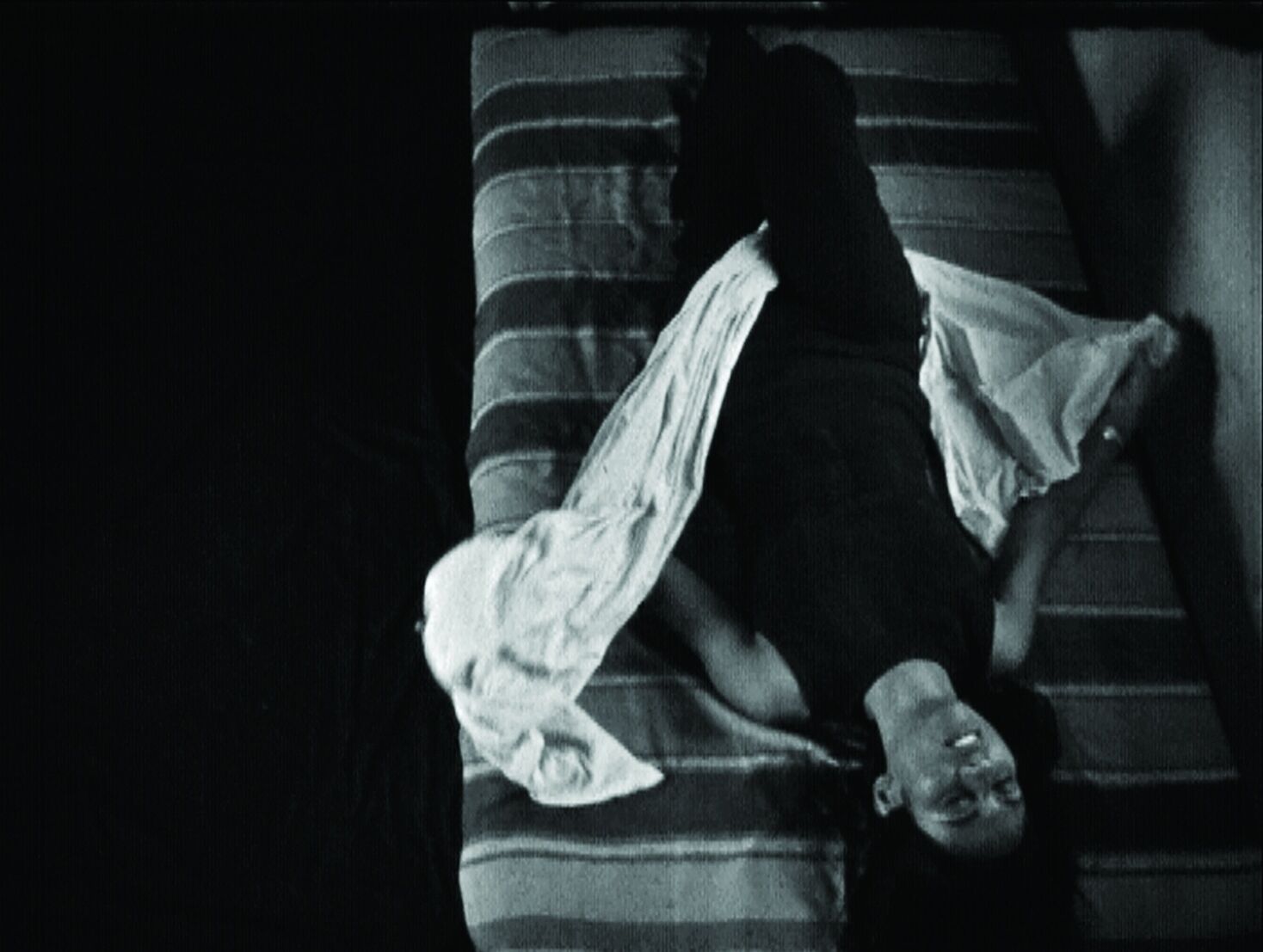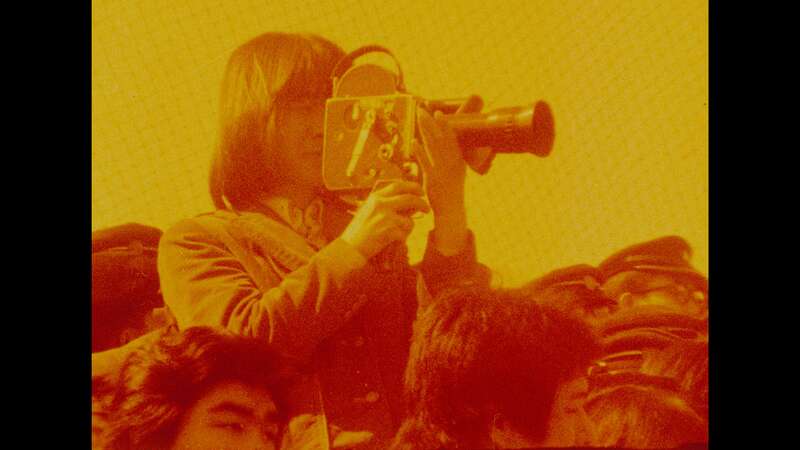
Han Ok-hee, Untitled 77-A, 1977, film still, courtesy of Asia Culture Center (ACC).
Abundant Feminisms: A conversation with Erika Balsom
Can we rethink notions of linear progress? How do feminist filmmakers redescribe reality? And what kind of conversations should we be having across generations? Film scholar and critic Erika Balsom is the author of books like Exhibiting Cinema in Contemporary Art
(2013) and After Uniqueness: A History of Film and Video Art in Circulation (2017). During the pandemic, she started researching feminist nonfiction films with curator and director Hila Peleg, which led to the exhibition No Master Territories (2022–2023, Haus der Kulturen der Welt, Berlin, and Museum Sztuki Nowoczesnej, Warsaw) and the accompanying edited volume Feminist Worldmaking and the Moving Image (2022). Following this research, Balsom composed the film programme Cut the Line at the Beursschouwburg, Brussels. Julia Alting spoke with her about the problems with the feminist wave model, structures of forgetting, and claims of novelty. ‘These films try to represent the world in a way that would create change.’
Julia Alting
29 nov. 2023 • 14 min
J.A.: No Master Territories showcased a plethora of nonfiction feminist films from different geographical and historical contexts, with diverse political positions and aesthetics, organised loosely around themes, and combining realist and experimental strategies. The exhibition featured, for example, Mona Hatoum’s So Much I Want to Say (1983), where the desire for speech is repeated over and over again; a woman moving fabric between her legs in Nalini Malani’s Onanism (1969); Grupo Chaski’s Miss Universo en el Perú (1982), which documents women protesting class inequality during the Miss Universe contest in Peru; or closeups of different vulvas in Alice Anne Parker’s Near the Big Chakra (1971). I sense a desire in the exhibition that resonated with me, to reclaim feminisms from a neoliberal and individual logic of liberation, and a wish to foreground this ‘counter archive’ of experimental film made by women in a decentred, global perspective. How did you and Hila Peleg approach the research?
E.B.: There were two paths. One was immersing myself in feminist theory, trying to map certain debates around feminist film historiography and trying to think about what had happened in feminism since #MeToo, or since Hillary Clinton. This meant reading film scholars like Isabel Seguí and Shilyh Warren, and also theorists like Nancy Fraser and Chandra Talpade Mohanty. Reading the debates about ‘girlboss’ feminism – which centres the neoliberal individual – I started thinking about the feminist critique of feminism that needs to be made today.
The other path was to watch as many nonfiction films made by women as we could. We enlisted the help of different collaborators – artists, archivists, scholars – from different places in the world to suggest films. I also looked at feminist film festival catalogues, from the early 1970s to the mid-1980s. We did not want to go with the handful of names that always circulate (Agnès Varda or Chantal Akerman, for example). This is where the two paths of the research joined together. We often encounter a new canon of elite female auteurs today. My question was: is this the neoliberal version of feminism within the world of cinema? What does it mean that film culture constantly returns to the same handful of women filmmakers, mostly from Europe, with large bodies of feature-length work made on 35 mm? We were interested in exploring an expanded idea of feminist film history. This meant focusing on nonfiction – meaning documentary and experimental film and video – and on formats like Super 8, 16 mm, and video. It also meant thinking about short films. This opened up a huge field. We decided to adopt abundance as a guiding historiographical principle, rejecting the idea that women are missing from the history of cinema because there were not very many of them making films. You just need to look in different places, with different criteria. In the end, we included people like Varda and Akerman, too, but with non-filmic or lesser-known work.
J.A.: There are many strong, feminist critiques of linear patriarchal history that erases women. However, the history of feminism – at least in its current Eurocentric forms – often erases racial, geographical, and cultural difference and projects a Hegelian notion of progress. I am interested in this connection between chronology and geography: if you take into account multiple geographical–historical contexts, is it inevitable that linear chronology does not work anymore, or at least skews the story?
E.B.: The chronological writing of feminist histories tends to use the narrative of waves: they come, they crash, and then they retreat. Later, another wave comes along and then it too retreats. It suggests that failure is inevitable and feminist activism is intermittent. The temporality of waves also very much reinscribes the dominance of Euro-American contexts. Different countries have different temporalities in terms of when a moment of feminist energy comes to the fore. For example, in South Korea, it was after the transition to democracy in the late 1980s, and in India, there was a flurry of movement in the early 1980s. But according to the Eurocentric narrative, the early 1970s is the big ‘second wave’ moment. We wanted to present a more fluid sense of time. This is also why we didn’t adopt a strict periodisation. We say the exhibition concentrates on the period of the 1970s to the 1990s, but actually, we included work that goes back to the late 1920s, and work from the present as well. There’s definitely a significant concentration of work made between the 1970s and the early 1990s, but we wanted to get away from the idea of generational waves that can be mapped easily and also to emphasise that these are ongoing traditions.
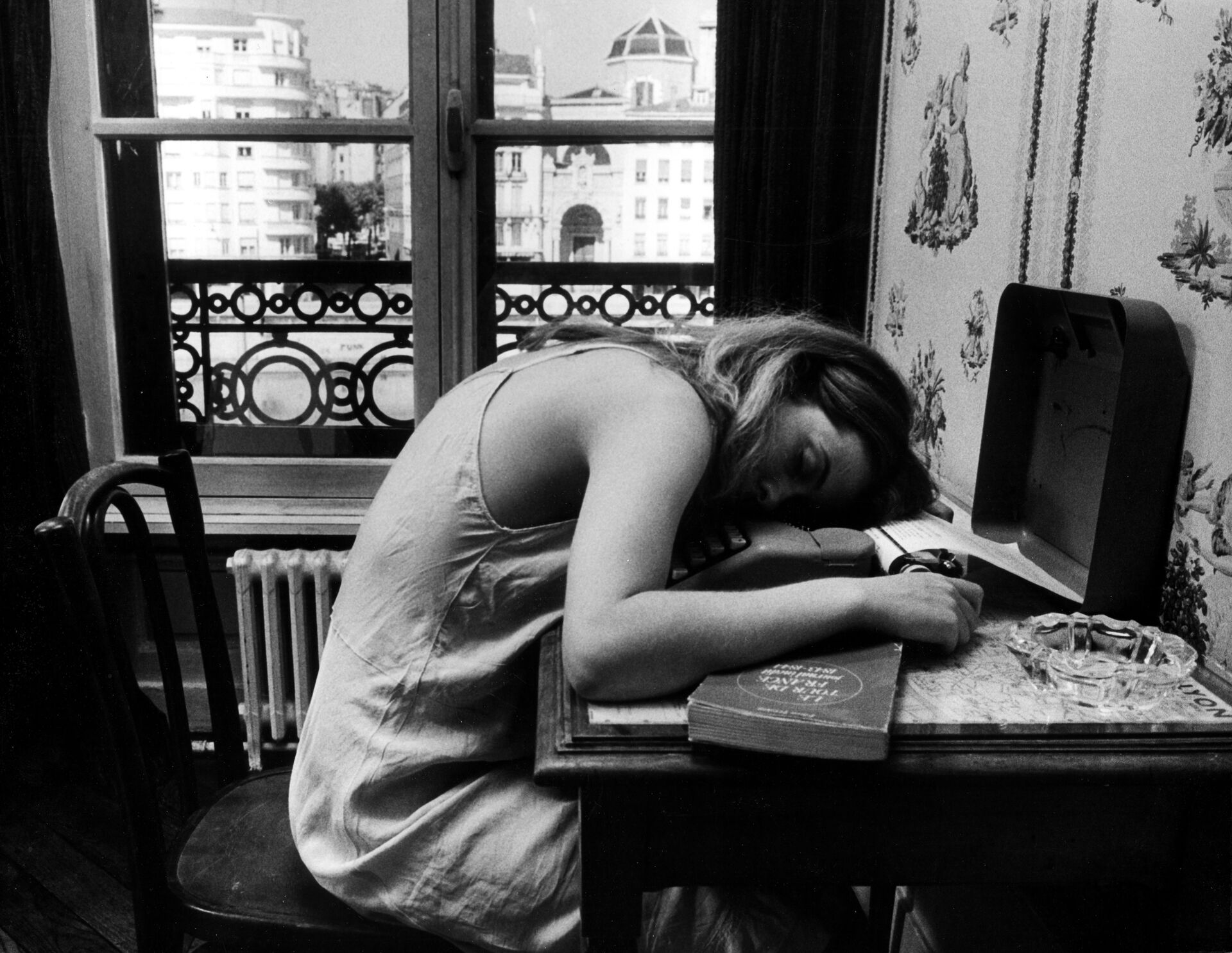
Claudia von Alemann, Blind Spot (Die Reise nach Lyon / Le voyage à Lyon), 1981, film still, courtesy of Stiftung Deutsche Kinemathek.
J.A.: The wave model also often essentialises what was happening at a certain moment, and everything within that wave then becomes homogenised.
E.B.: Exactly. For instance, ‘second-wave feminism’ in the US (with its gravity point the 1970s) becomes a white, middle-class, perhaps essentialist moment, when in fact, if you do any reading at all, you realise that this is a complete mischaracterisation of what was happening in feminism in that country at that time. We wanted to tell feminist film history in a feminist way. We needed to not only think about our object but also about our method. This is in part my interest in Claudia von Alemann’s Blind Spot / Le Voyage à Lyon (1981), a film about a woman who decides to research nineteenth-century feminist Flora Tristan in non-traditional ways. We broke our own rule of focusing on nonfiction to include this fiction film, but we felt it was important to foreground that alongside its fictional narrative, it also proposes an essayistic discourse on feminist historiography. The line between fiction and nonfiction is fluid, in any case.
J.A.: I think that the essentialisation of the wave moments also forecloses historical material from interrupting the present: previous moments of feminist thought are then interpreted as insignificant, as if they cannot bring us something today.
E.B.: Exactly. The wave recedes and then presumably is replaced by a different wave, which brings with it a different set of discourses or emphases. It is a narrative of discontinuity. We really wanted to move away from the idea that feminism dies at particular moments and instead insist that there is a long continuity of production and activism.
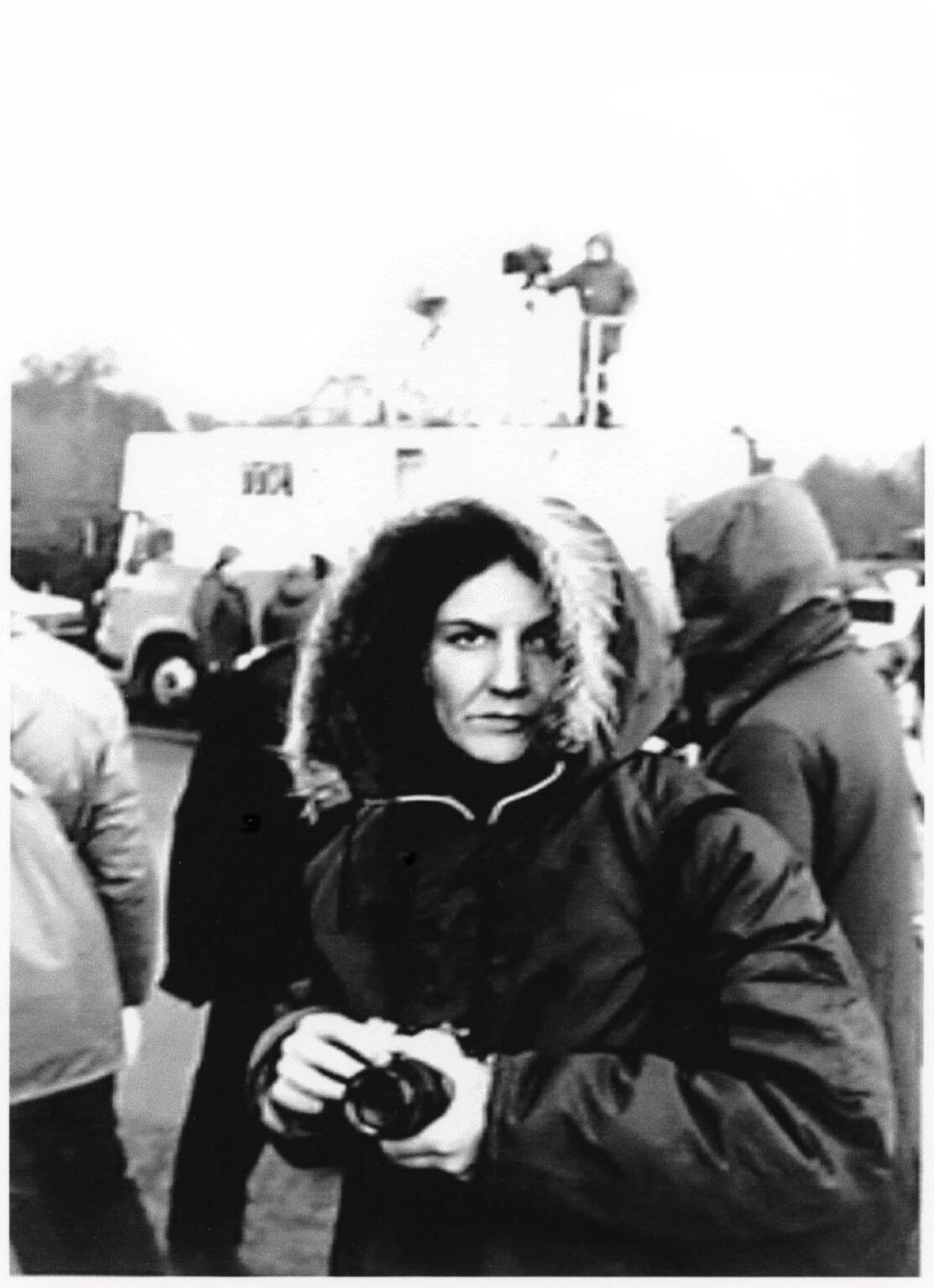
Lis Rhodes at Greenham Common, 1984, courtesy of the artist.
J.A.: You reference Lis Rhodes’s withdrawal from the Film as Film exhibition in the Hayward Gallery in London in 1979. The exhibition No Master Territories is in a way in dialogue with her critique of a type of linear film history that forgets women, as well as with the gesture of a tokenist invitation and her refusal to then insert the research on women in a historical framework that does not support it. In her 1979 text ‘Whose History?’, she first describes linear history and then proposes an alternative to it:
It is as though a line could be drawn between past and present and pieces of a person’s life and work pegged on it; no exceptions, no change – theory looks nice – the similarity of item to item reassuring – shirt to shirt – shoulder to shoulder – a inflexible chain, each part in place. The pattern is defined. Cut the line and chronology falls in a crumpled heap. I prefer a crumpled heap, history at my feet, not stretched above my head.Lis Rhodes, ‘Whose History?’, Film as Film: Formal Experiment in Film 1910–1975 (London: Arts Council England, 1979), 119–120. Republished in Erika Balsom and Hila Peleg, eds., Feminist Worldmaking and the Moving Image (MIT Press, 2022), 117–123.
We also know that the critique of the erasure of women from patriarchal history by many white feminists in the 1970s was accompanied by another kind of forgetting: the erasure of (racial, class, cultural, geographical, sexual) difference between women. You said once that ‘feminism is not innocent’, and I like that a lot. What is your position towards the legacy of the long 1970s? What kind of intergenerational conversations should we be having?
E.B.: We had the feeling that intergenerational dialogues were not happening enough, or to put it differently, that there was amnesia in the contemporary moment around the fact that many debates we are having today have happened before. For example, this idea of the ‘female gaze’ that circulates today rehashes the debate on a ‘feminine aesthetic’ that occurred in the 1970s, but this is seldom acknowledged. The claim that certain filmic techniques are somehow inherently biologically feminine is always bound up in a spurious logic of prescription and essentialisation. The current discussion has not learned the lessons of a whole earlier set of debates. It is as if some of those reference points have not been successfully transmitted through time. But as Chandra Talpade Mohanty notes, rewriting and remembering the feminist past has long been an important part of feminism. Lis Rhodes’s work on the Film as Film exhibition is a great example of this, but not the only one: many women’s film festivals in the 1970s were very engaged in intergenerational historical projects, in attempts to go back and look for women’s presence within the history of cinema. It was happening in film programming at that time much more than it was happening in feminist film scholarship, which was often concerned with a theoretical critique of Hollywood. We were interested in picking up on this idea of curatorial work as revisionist historiography.
The idea of an intergenerational dialogue presumes that we speak to the past and the past speaks to us. In Feminist Worldmaking and the Moving Image, there’s an intergenerational dialogue between Julia Lesage and Shilyh Warren, and it’s interesting to see where they hold certain things in common and also where they diverge.In ‘“It was there all along”: An Intergenerational Dialogue About Feminism, Realism and Documentary’, Feminist Worldmaking and the Moving Image, eds. Erika Balsom and Hila Peleg (MIT Press, 2022), 141–164. When thinking about the exhibition as an intergenerational dialogue, this encounter across time takes a different shape. We tried to create a forum within which the voices of the past could be heard in the present and also confront one another in their affinities and contradictions.
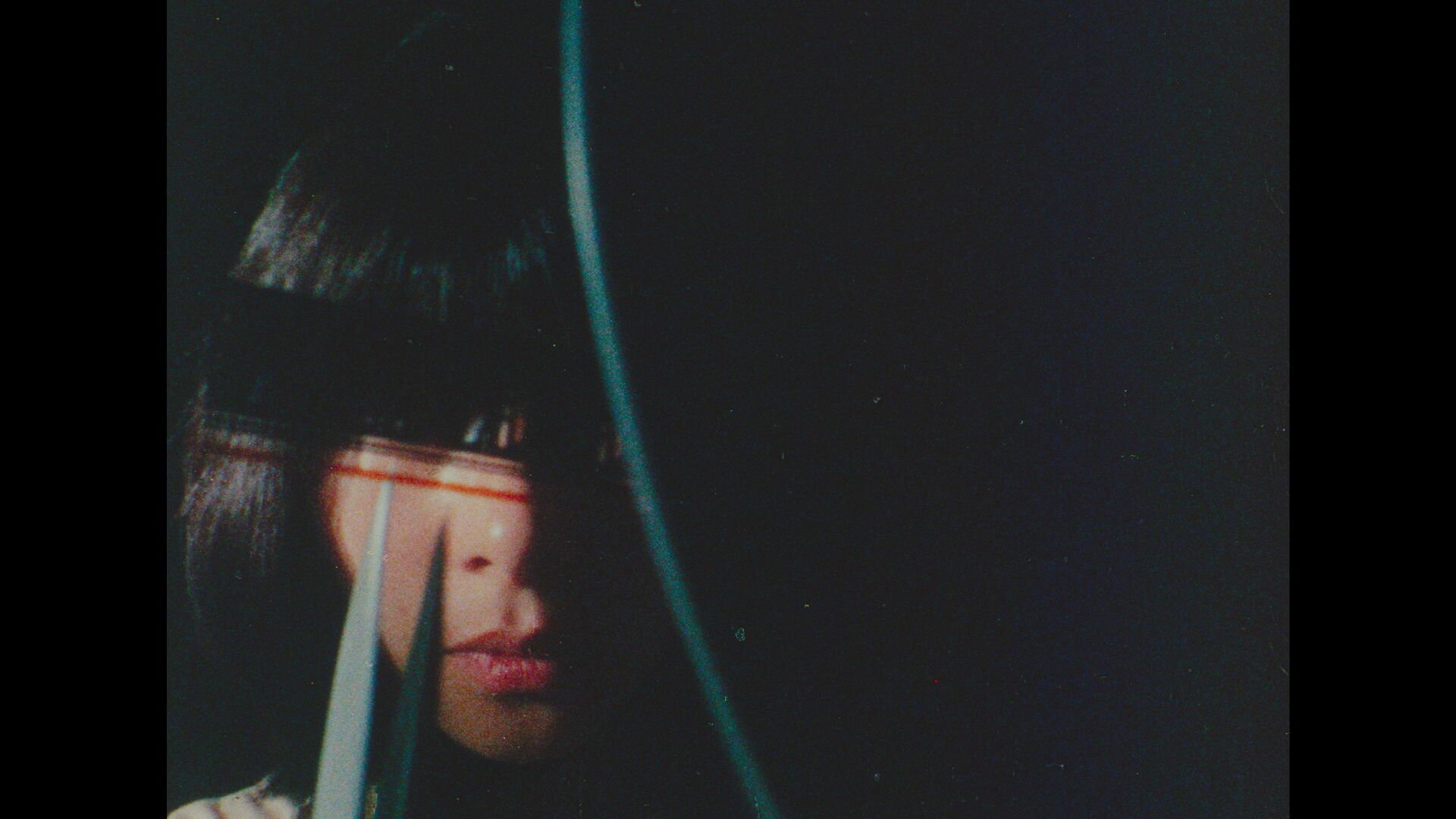
Han Ok-hee, Untitled 77-A, 1977, film still, courtesy of Asia Culture Center (ACC).
J.A.: The way in which the feminist material of the past still speaks so much to us now is also completely frustrating: it confronts us with the fact that maybe not that much has actually changed, and the same issues persist. For example, I studied art history ten years ago, and still a mostly patriarchal canon was taught to me, something that was criticised already fifty years ago, and even before then. We encounter again and again the same erasures.
E.B.: It is very depressing. Even though we’re familiar with all the philosophical critiques of historical progress, I think we still want to believe that real gains have been made, and certain problems have been solved, and so on. In fact, inequality and oppression persist. The optimism of neoliberal feminism is part of the problem. It gauges improvement by there being more female CEOs or more women making Hollywood films. But perhaps it’s more important to think about what hasn’t changed and what still needs to be done.
J.A.: The film Sisterhood™: Hyping the Female Market by Paper Tiger Television (1993) starts with the metaphor of people ascending stairs, to illustrate the idea of the linear advancement of humankind; in the final scenes of the film, we see a woman on a fitness machine on a steep incline. She does not move forward; there is no progress.
E.B.: That video is wild to me, because it’s from 1993. It is amazing how it was already debunking the myths of neoliberal feminism thirty years ago.
J.A.: Exactly, it feels so contemporary.
E.B.: That was not the common talking point in 1993. It’s a really fascinating work, in terms of its prescience.
J.A.: Currently, there might be more of a commonly held sense that ‘progress’ is not linear, with the setback in abortion rights, the rise of fascisms globally, devastating wars, neocolonialism, and more. What should we do with the notion of progress? Do we hold onto it? Is it necessary for political activism?
E.B.: It is very tricky. Obviously, there is the idea of holding onto a utopian horizon towards which we want to move, even if we know we can’t get there. Maybe that is one kind of belief in progress that remains necessary. I would say that this question also relates to the concept of ‘worldmaking’, which for us was an important way of thinking about the practices included in the exhibition. We understood worldmaking as a redescription of reality that changes the thing described. It’s not necessarily progress, but it is difference and change. How can we see these films as redescribing reality from a feminist point of view, whatever that might mean? You said feminisms in the plural earlier, and that is something I’m on board with. Feminism can mean many things. These films offer different ways of thinking about what a feminist perspective might be. They try to represent the world in ways that would create change or enable different visions to emerge. This is why nonfiction practice – whether that means documentary or essay film, video art or experimental film – was important to us. These are films that are in some way anchored in the world, rather than in a fictional world. Fiction has tremendous political and imaginative powers, to be sure, but we were interested in films that somehow had a stake in redescribing existing realities from points of view that have been occluded or marginalised.
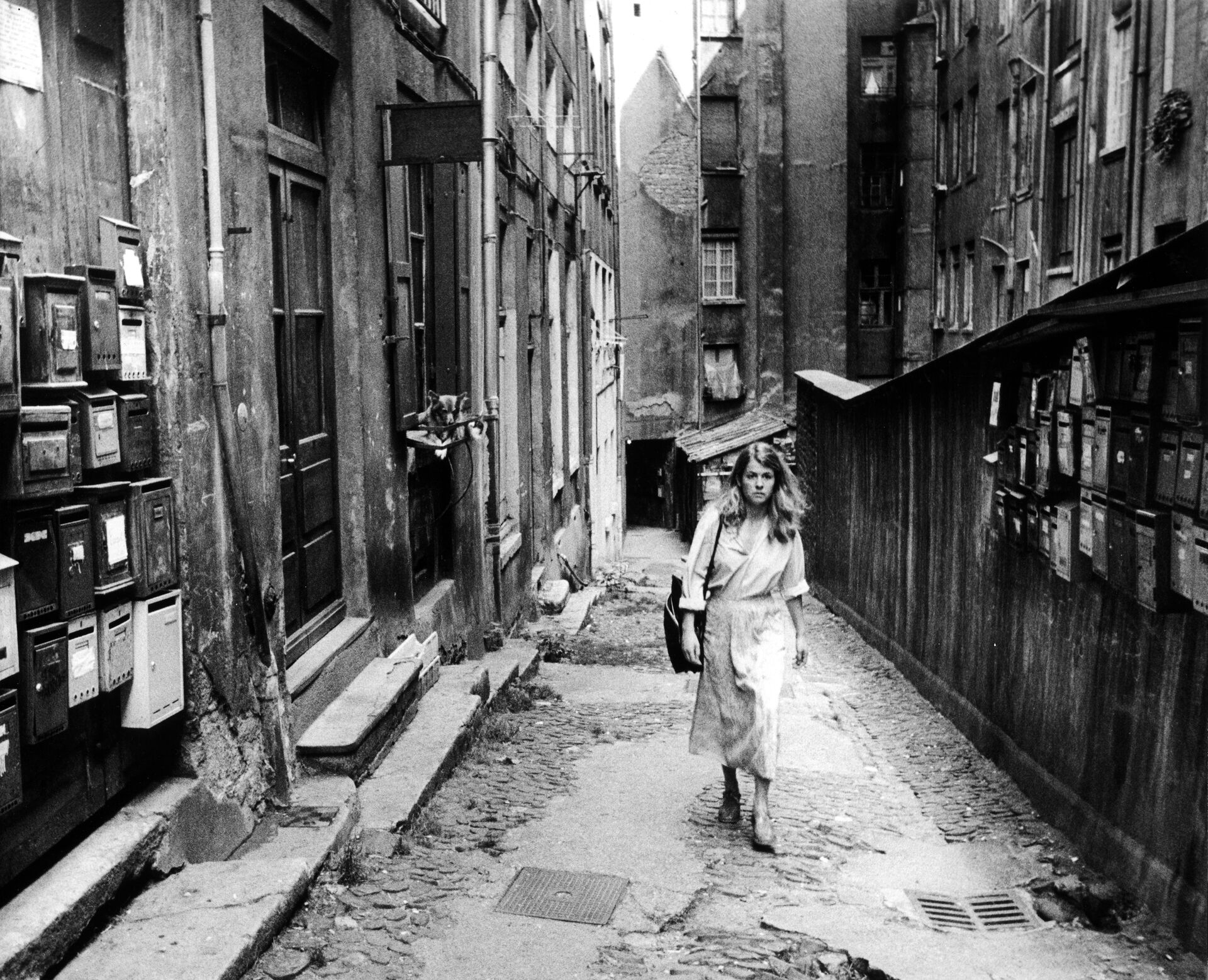
Claudia von Alemann, Blind Spot (Die Reise nach Lyon / Le voyage à Lyon), 1981, film still, courtesy of Stiftung Deutsche Kinemathek.
J.A.: Redescription also immediately implies a different temporality than linear progress: a repetition instead of a step on the ladder, perhaps. It begs a larger question about difference and solidarity. Your approach to the research for No Master Territories made me think of Édouard Glissant, the Martiniquan thinker and author of Poetics of Relation (1993), who writes about relationality and how we can conceive of points of contact without a harmful universalist framework. You’ve also emphasised the fluidity of the term ‘woman’. Could you elaborate on your thoughts on an inclusive definition of feminism?
E.B.: We were not at all interested in prescribing what a woman is, but rather in exploding the category. In our curatorial statement, we quoted Lola Olufemi, who states that ‘woman’ is ‘a strategic coalition, an umbrella under which we gather in order to make political demands’.Olufemi, Lola. Feminism, Interrupted: Disrupting Power (Pluto Press, 2020), 65. She hypothesises that ‘in a liberated future, it might not exist at all.’ In my view, this would be a very welcome thing – but we’re not there yet. What we can do is try to expand and twist the images and definitions of ‘woman’ that dominate our culture. To this end, we were interested in foregrounding the heterogeneity and eclecticism of feminist film practice, by showing a wide breadth of the positions, aesthetics, subjectivities, and stories that can be grouped under that umbrella. Paper Tiger Television’s Sisterhood™ shows how the idea of sisterhood has become a trademark, a hollowed-out thing. We see that the emancipation of an elite few rests on the ongoing oppression of the many, as sneaker brands make advertisements filled with images of female empowerment but produce their products overseas, using a mostly female and poorly paid workforce. Historically, in the 1970s, there was sometimes an essentialist assumption that all women share something simply by virtue of being born women. This is a big problem; it can lead to all kinds of marginalisation and exclusion. The question becomes: how do you create unity without reproducing the violence of homogenisation? Solidarity is a way of thinking about that. It has to be constructed across difference. As a gesture towards the importance of this attitude, we chose to exhibit Joyce Wieland’s Solidarity (1973) on a large screen at the centre of the space. It’s a process, something that has to be built and fought for.
This conversation is co-published and co-edited by rekto:verso. You can read it in Dutch on the website of rekto:verso .
